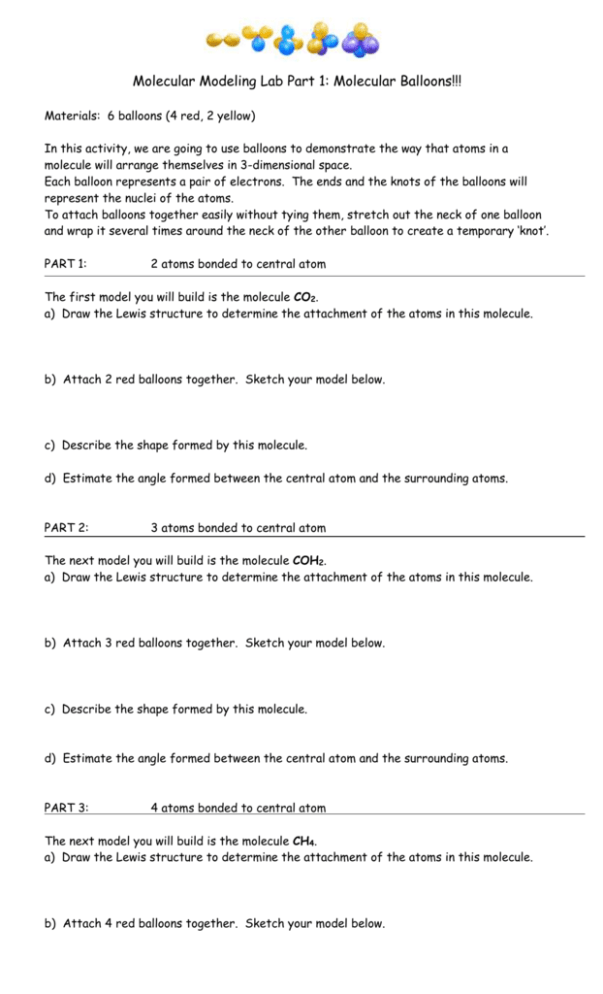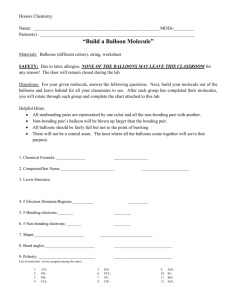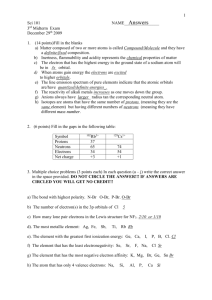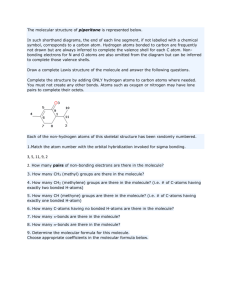Molecular Balloons
advertisement

Molecular Modeling Lab Part 1: Molecular Balloons!!! Materials: 6 balloons (4 red, 2 yellow) In this activity, we are going to use balloons to demonstrate the way that atoms in a molecule will arrange themselves in 3-dimensional space. Each balloon represents a pair of electrons. The ends and the knots of the balloons will represent the nuclei of the atoms. To attach balloons together easily without tying them, stretch out the neck of one balloon and wrap it several times around the neck of the other balloon to create a temporary ‘knot’. PART 1: 2 atoms bonded to central atom The first model you will build is the molecule CO2. a) Draw the Lewis structure to determine the attachment of the atoms in this molecule. b) Attach 2 red balloons together. Sketch your model below. c) Describe the shape formed by this molecule. d) Estimate the angle formed between the central atom and the surrounding atoms. PART 2: 3 atoms bonded to central atom The next model you will build is the molecule COH2. a) Draw the Lewis structure to determine the attachment of the atoms in this molecule. b) Attach 3 red balloons together. Sketch your model below. c) Describe the shape formed by this molecule. d) Estimate the angle formed between the central atom and the surrounding atoms. PART 3: 4 atoms bonded to central atom The next model you will build is the molecule CH4. a) Draw the Lewis structure to determine the attachment of the atoms in this molecule. b) Attach 4 red balloons together. Sketch your model below. c) Describe the shape formed by this molecule. d) If the shape you have achieved is a flat ‘cross’ shape, let’s test to see if that is actually the most stable arrangement for this molecule. Perform a collision experiment with your molecule by bouncing it around a bit or ‘colliding’ it with your classmates’ molecules. The shape of your molecule should change to a more stable conformation. Describe and draw this new shape. e) Estimate the angle formed between the central atom and the surrounding atoms. PART 4: Nonbonding electrons on the central atom The next model you will build is the molecule NH3. a) Draw the Lewis structure to determine the attachment of the atoms in this molecule. b) Attach 3 red balloons together. Add a yellow balloon to represent the nonbonding pair of electrons. Sketch your model below. c) Describe the shape formed by this molecule, focusing on the position of the atoms only, not the nonbonding electrons. The next model you will build is the molecule H2O. a) Draw the Lewis structure to determine the attachment of the atoms in this molecule. b) Attach 2 red balloons together. Add two yellow balloons to represent the nonbonding pairs of electrons. Sketch your model below. c) Describe the shape formed by this molecule, focusing on the position of the atoms only, not the nonbonding electrons.








